How do I love foxtail agaves (A. attenuata)? Let me count the ways:
-
- This highly popular succulent looks equally good in pots or in the garden.
- Rosettes attain a manageable 5' in diameter over time.
- With soft, flexible leaves lacking barbs or points, foxtails are among the few agaves that are totally harmless.
- As the only trunk-forming agave, they lend height to garden spaces and make beautiful backdrops.
- En masse, they suggest a hedge of huge green flowers.
- Plus, Agave attenuata is easy to propagate and grows in climates that other agaves won't!
How Foxtails are Different (and Better)
The species name attenuata refers to the leaves, and means “tapers gradually to a point.” Well so do the leaves of all agaves. It might have been better to give it a Latin name that means soft-leaved, thin-leaved or lacking spines! Oh well.
Agave attenuata also is unusual in that it does well in humid, semitropical regions of the US. A photo in my book Designing with Succulents shows foxtails in Hilo, Hawaii.
And these I saw in a garden in Paradise Valley near Phoenix.

Foxtail agaves (Agave attenuata) in Arizona
The farther east from the Pacific Ocean, the more these thin-leaved agaves are susceptible to frost in winter and sunburn and heat stress in the summer. They’re usually fine under lacy trees, but you’ll need to hose the centers of the plants occasionally to remove fallen leaves. The plants do appreciate the extra water.
Foxtails make a nice border for a pathway or driveway, but keep in mind they grow in the direction of greatest sunlight. Since they're are trunk forming, they may lean where you don’t want them.

Foxtail agaves have naturalized on a cliffside in Laguna Beach, CA
About that big, bushy bloom stalk
Agave attenuata is from central Mexico and is rare in the wild. Plants bloom once in their lifetimes, in midwinter. The unbranched, arching, bushy stalk is why it’s called foxtail agave.
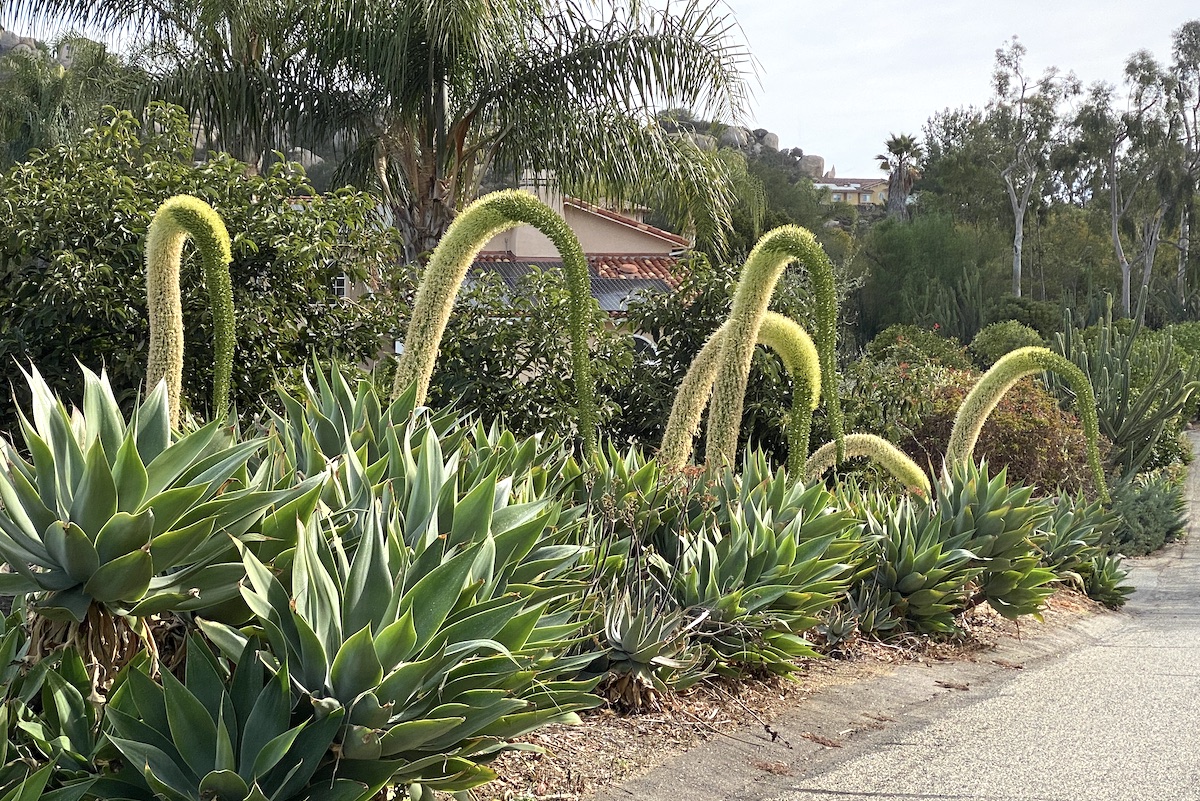
This streetside colony, shown in bloom in December, was later destroyed by agave snout weevil
Buds line a stalk that emerges from the center of the plant. These open into chartreuse flowers with long stamens and pistils. My neighbors decorate the tips of foxtail bloom spikes when they’re still easy to reach. By Christmas the ornaments are high overhead.
Incidentally, you don’t have to let the stalk grow. Cutting it off won’t save the plant from dying, but at least you won’t have a long stalk to get rid of of later on. A truncated stalk may produce a mass of offsets, which look kinda cool and also can be harvested and planted.
How to Propagate Foxtail Agaves
Flowers along the stalk mature into miniatures of the mother plant. When they’re teacup sized and come off easily, plant them in a tray of coarse potting mix. Keep out of direct sun and barely moist until the little plants root, then transplant them into larger pots.
That’s fairly easy, but there’s an even better way to propagate Agave attenuata, and you don’t have to wait for it to bloom. All you need is a friend or neighbor with a colony. At any time of year, it’s possible to remove offsets that grow on the trunk or at the base of a rosette.

It's easy to remove Agave attenuata offsets that grow along the trunk
Little clones may already have roots. In the video I harvest one and get it off to a good start in a nursery pot. In six months or so I'll use it to fill a gap in the garden.
When repositioning Agave attenuata, all it needs is enough trunk to anchor it. Roots will grow from even a stub. Like most succulents, foxtails are not fussy about soil as long as it drains well.
Pests and Problems
Foxtail agaves are seldom bothered by pests. I used to think that agave snout weevils left them alone, but unfortunately that’s not the case. You’ll need to treat your foxtails preventatively, as you routinely do your other agaves. Learn more about snout weevil treatment and prevention.
Deer may eat foxtail agaves when food is scarce. Snails can be a problem too. I use Sluggo snail bait, because it doesn’t harm pets or wildlife.
Beige patches on leaves indicate sunburn. If the weather suddenly changes from weeks of cool overcast to temps above 80 and full hot sun, drape foxtails that are out in the open with lightweight fabric or shade cloth. The plants will acclimate in about a week.
The biggest threat to foxtail agaves
By far, the biggest threat to foxtail agaves is cold. I’m in Zone 9B, between Southern California’s coast and desert. I cover my foxtails with frost cloth when freezing temps are forecast.
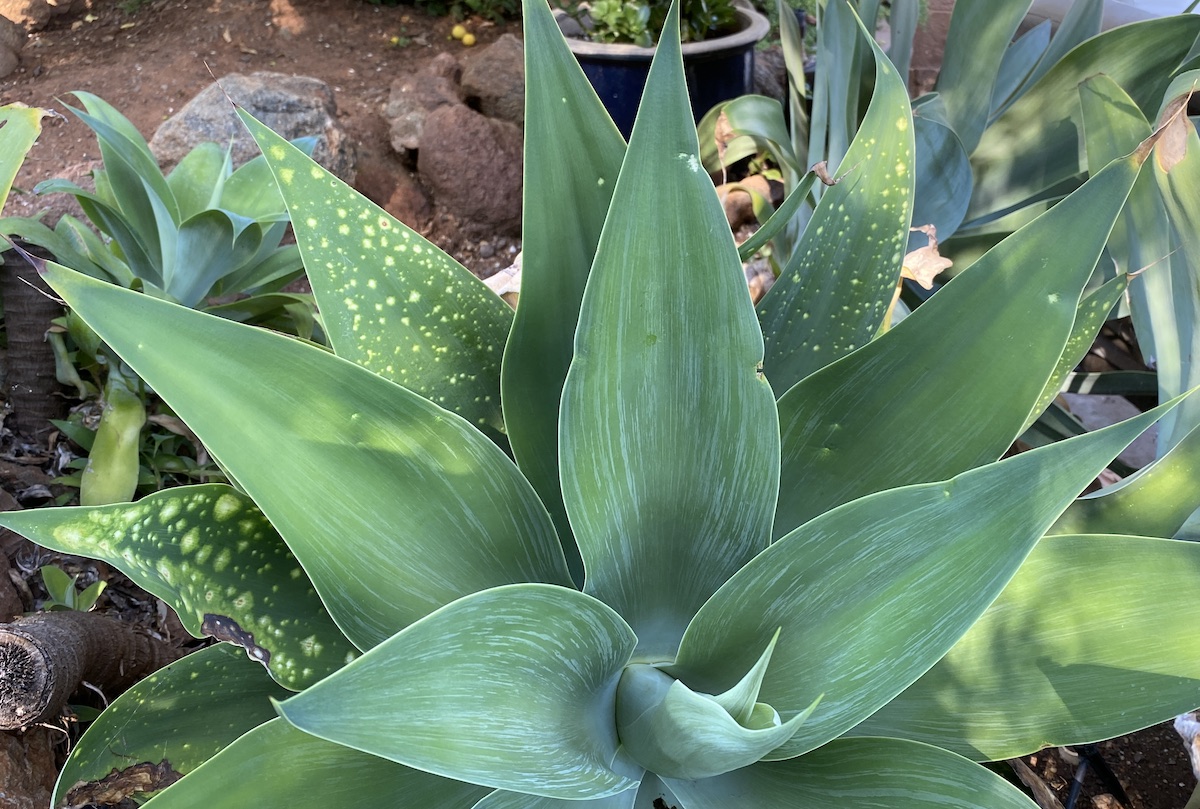
White spots on foxtail agaves result from the impact of hail
The question I get asked most about foxtail agaves is what these tiny white spots are. It’s hail damage, which people generally notice about a week after a storm. Such pitting doesn’t harm the plants, and in a few months it’s barely noticeable. Typical of rosette succulents, new leaves that grow from the center hide older leaves.
Gorgeous Variegates and Cultivars
Forms of Agave attenuata with blue-gray leaves include Agave attenuata 'Boutin Blue' and 'Nova'. These may (but not always) have shorter, broader leaves and erect rather than pendant flower stalks.

Agave attenuata 'Boutin Blue'
Variegates of Agave attenuata are prized by home gardeners and collectors alike, but light-colored or striped plants tend to be weaker due to less chlorophyll. Named hybrids of Agave attenuata ‘Variegata’ include ‘Kara’s Stripes’ and ‘Ray of Light’.
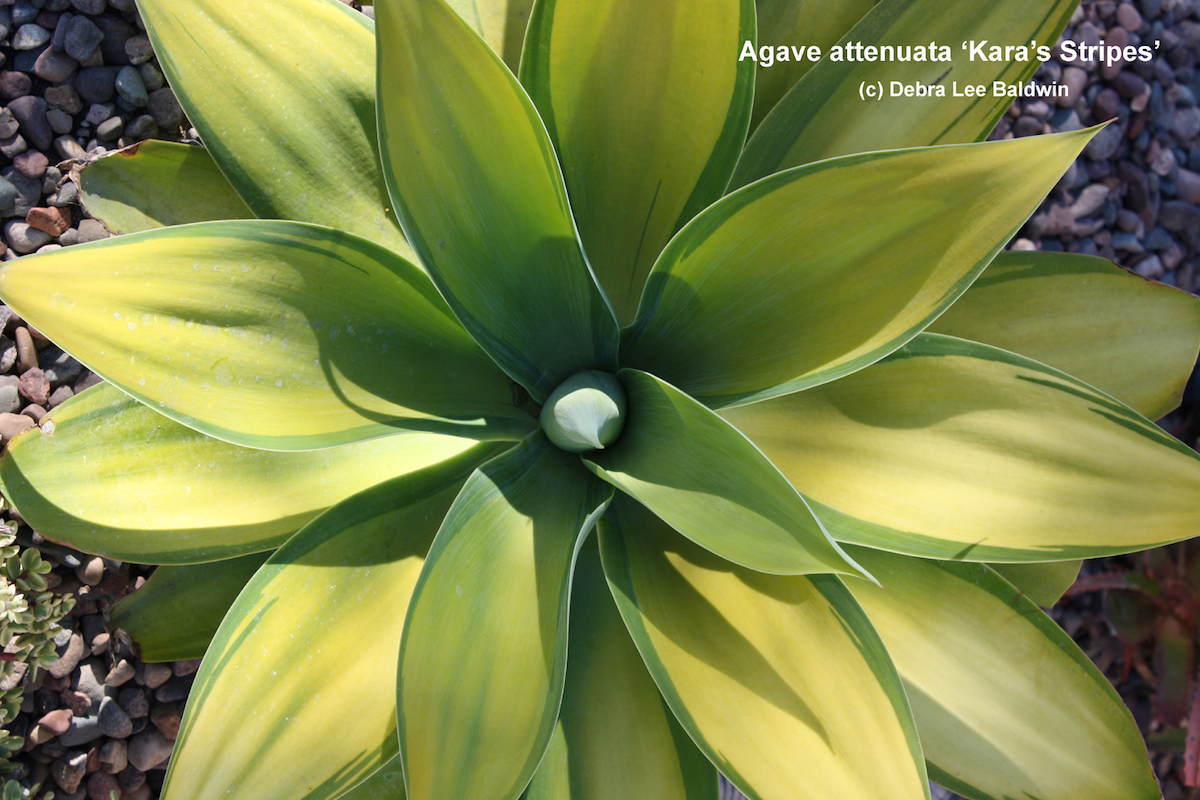
Agave attenuata 'Kara's Stripes'
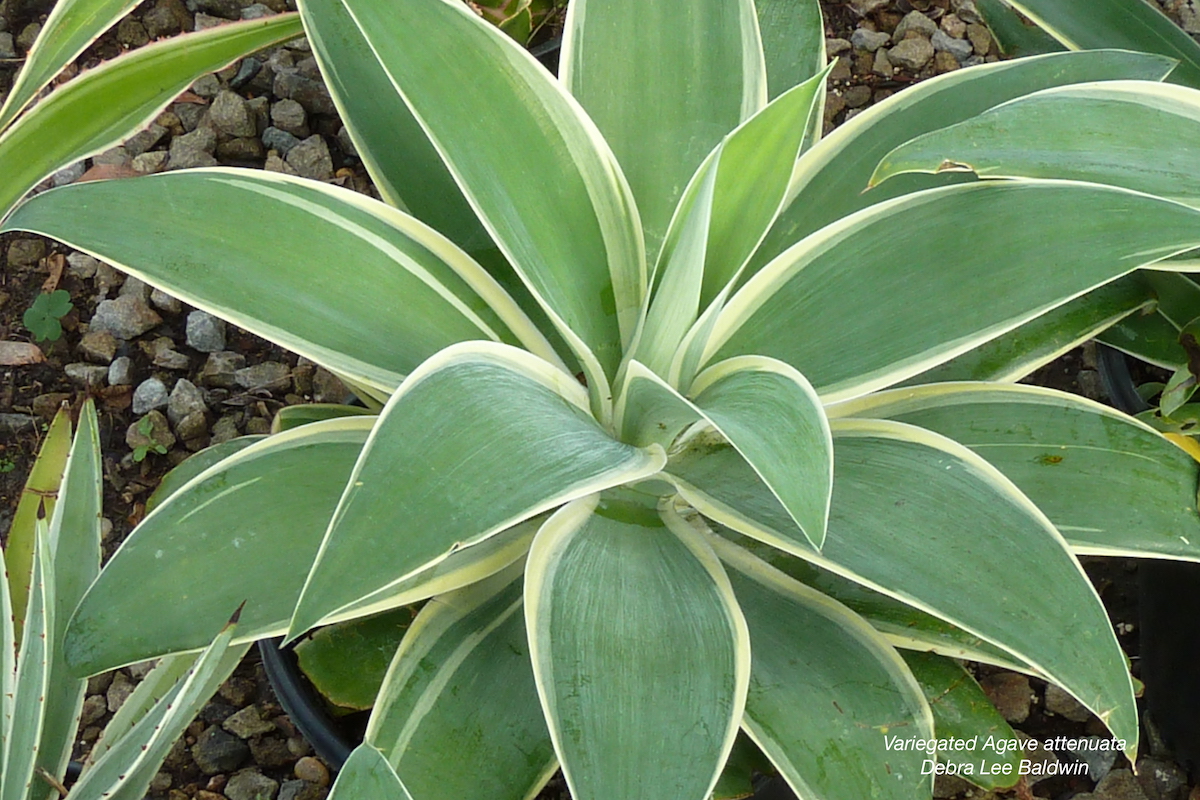
Agave attenuata 'Ray of Light'
Plants started from seed resemble their parents and each other, but will vary just as no two human siblings are exactly alike. Agave attenuata variegates seldom offset, are tricky to tissue culture, and take a decade or more to bloom (if ever), so don’t expect see a lot of them on the market.
In the early 1960s hybridizer David Verity of UCLA's botanical garden crossed Agave attenuata with Agave shawii, resulting in Agave ‘Blue Flame’. Its smooth, flexible leaves lack teeth on their margins and curve inward, making terminal spines less treacherous. Later San Diego hybridizer
Kelly Griffin crossed Agave attenuata with Agave ocahui, resulting in Agave ‘Blue Glow’. It's become one of the most popular landscape succulents, often planted in multiples because of its manageable size (3 feet in diameter), painterly colors, perfect symmetry, and solitary, nonpupping habit.

Agave 'Blue Flame' (top) and Agave 'Blue Glow'
Here both are shown together at Succulent Gardens nursery south of San Francisco. Btw, this is one of my favorite photos of succulents ever!
Related Info on This Site
Agave Snout Weevil Prevention and Treatment
Agave snout-nosed weevil is a half-inch-long black beetle with a downward-curving proboscis that enables it to pierce an agave’s core, where it lays its eggs. Grubs hatch, consume the agave’s heart, then burrow into the soil to pupate.
Your Agave’s Blooming–Now What?
Your agave is blooming! Now what? In my new video, Q&A and photo gallery you’ll find expert advice, agave IDs and how to start the plants from seeds and bulbils.
Agaves: Uses, Photos, IDs and Varieties
With the exception of a few soft-leaved and variegated varieties, agaves want sun—the more the better in all but desert climates. Most are hardy to the mid- to high-20s F, and some go a lot lower. Sharp points at leaf tips and along leaf edges can make agaves treacherous. I snip about a quarter inch from leaves’ needlelike tips with garden shears.
The post Agave attenuata (Foxtail Agave) Care & Cultivation appeared first on Debra Lee Baldwin. Copyright © Debra Lee Baldwin.
from Debra Lee Baldwin https://ift.tt/7SU6dGQ
via IFTTT

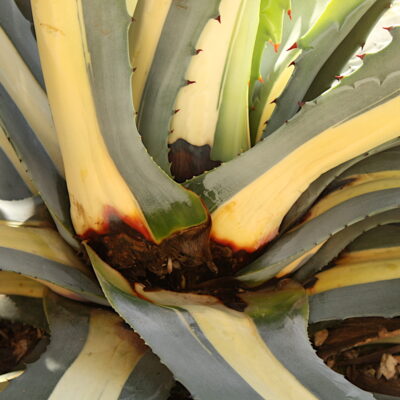
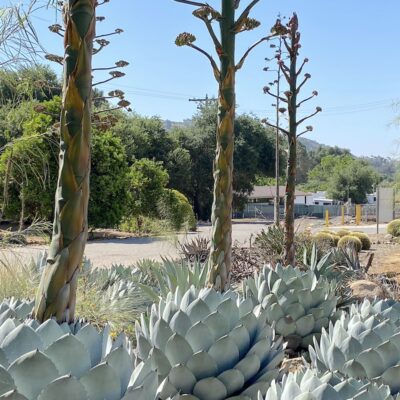
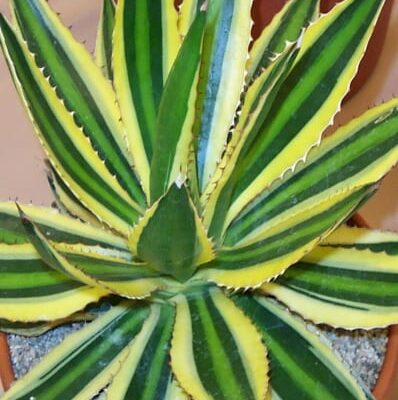
No hay comentarios:
Publicar un comentario